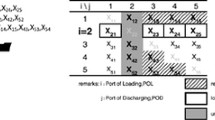Abstract
This paper formulates the empty container repositioning (ECR) problem, which is one of the most important issues in the container shipping industry, by running a model to generate the service route of feeder shipping in a dynamic environment. The objective is to reduce the disequilibrium of laden and empty containers. This paper first provides a literature review with the emphasis on the shipping scheduling and modelling of ECR. Second, a network model has been designed to find the optimum size of ship servicing a particular region. A simply ECR policy is tested to demonstrate an essential impact on the profit of a container transport system. With the aid of this heuristic shipping model, ECR is integrated with the tramp ship routing problem under dynamic condition.








Similar content being viewed by others
References
Di Francesco, M., Lai, M., & Zuddas, P. (2013). Maritime repositioning of empty containers under uncertain port disruptions. Computers & Industrial Engineering, 64, 827–837.
DNV, G. L. (2016). Maritime software. [Online] https://www.dnvgl.com/maritime/software.html. Accessed 19 Jan 2016.
Dong, J.-X., & Song, D.-P. (2012). Lease term optimization in container shipping systems. International Journal of Logistics Research and Applications, 15(2), 87–107.
Dong, J.-X., & Song, D.-P. (2012). Quantifying the impact of inland transport times on container fleet sizing in liner shipping services with uncertainties. OR Spectrum, 34(1), 155–180.
Gass, S. I., & Fu, M. C. (2013). Encyclopedia of operations research and management science (3rd ed.). New York: Springer.
Hutchins, R. (2015). Less container ship capacity forecast to be scrapped. New York: Journal of Commerce.
Institute of Chartered Shipbrokers. (2015). Containerisation, unitisation and intermodalism. In T. Mason (Ed.), Liner trades (pp. 103–128). London: Witherby Seamanship International Ltd.
Investment Weekly News. (2014). Research and markets; Ship fleet management system—market outlook report. [Online] http://search.proquest.com/docview/1626002420?OpenUrlRefId=info:xri/sid:primo&accountid=16210. Accessed 19 Jan 2016.
Karaboga, D. (2005). An idea based on honey bee swam for numerical optimization. Kayseri: Erciyes University, Engineering Faculty, Computer Engineering Department.
Karaboga, D., & Basturk, B. (2007). A powerful and efficient algorithm for numerical function optimization: Artificial bee colony (ABC) algorithm. Journal of Global Optimization, 39(3), 459–471.
Liu, L., Wang, K. Y., & Yip, T. L. (2013). Development of a container port system in Pearl River Delta: Path to multi-gateway ports. Journal of Transport Geography, 28, 30–38.
Meng, Q., & Wang, S. (2012). Liner ship fleet deployment with week-dependent container shipment demand. European Journal of Operational Research, 222(2), 241–252.
Meng, Q., Wang, T., & Wang, S. (2012). Short-term liner ship fleet planning with container transshipment and uncertain container shipment demand. European Journal of Operational Research, 223(1), 96–105.
Olivo, A., Di Francesco, M., & Zuddas, P. (2012). An optimization model for the inland repositioning of empty containers. Maritime Economics & Logistics, 15, 309–331.
Progressive Digital Media Transportation News. (2015). OOCL orders six mega container vessels for $951.6m. London: Progressive Digital Media.
PRWEB, (2013). Growth of Fleet Management Systems Market to 2018 Forecast at a CAGR of 22.8% in a New Research Available at ReportsnReports.com. [Online] http://www.prweb.com/releases/Fleet-management-systems/2018-FMS-forecast/prweb11038928.htm. Accessed 19 Jan 2016.
Shui, C., & Szeto, W. (2015). An artificial bee colony algorithm for public bike repositioning. Sydney, The 37th Australasian Transport Research Forum (ATRF 2015).
Song, D.-P., & Dong, J.-X. (2011). Flow balancing-based empty container repositioning in typical shipping service routes. Maritime Economics & Logistics, 13, 61–77.
Song, D.-P., & Dong, J.-X. (2012). Cargo routing and empty container repositioning in multiple shipping service routes. Transportation Research Part B, 46, 1556–1575.
Song, D.-P., & Dong, J.-X. (2013). Long-haul liner service route design with ship deployment and empty container repositioning. Transportation Research Part B, 55, 188–211.
Song, D.-P., & Dong, J.-X. (2015). Chapter 6 empty container repositioning. In C. Lee & Q. Meng (Eds.), Handbook of ocean container transport logistics (pp. 163–208). Berlin: Springer.
Stopford, M. (2009). Maritime rconomics (3rd ed.). s.l.: Routledge.
Tran, N. K., & Haasis, H.-D. (2015). An empirical study of fleet expansion and growth of ship size in container liner shipping. International Journal of Production Economics, 159, 241–253.
Tran, N. K., & Haasis, H.-D. (2015). Literature survey of network optimization in container liner shipping. Flexible Services and Manufacturing Journal, 27(2), 139–179.
United Nations. (2014). Review of maritime transport. Geneva: United Nations.
United Nations. (2015). Review of maritime transport. Geneva: United Nations.
Varelas, T., et al. (2013). Optimizing ship routing to maximize fleet revenue at Danaos. Interfaces, 47(1), 37–47.
Vojdani, N., Lootz, F., & Rösner, R. (2013). Optimizing empty container logistics based on a collaborative network approach. Maritime Economics & Logistics, 15(4), 467–493.
Wolff, J., Herz, N., & Flamig, H. (2012). Report on case study empty container logistics Hamburg-Baltic Sea region. Hamburg: Hamburg University of Technology.
Xu, J. J., Yip, T. L., & Marlow, P. B. (2011). The dynamics between freight volatility and fleet size growth in dry bulk shipping markets. Transportation Research Part E, 47(6), 983–991.
Yip, T. L., Sun, X. Y., & Liu, J. J. (2011). Group and individual heterogeneity in a stochastic frontier model: Container teminal operators. European Journal of Operational Research, 213, 517–525.
Yip, T. L., & Wong, M. C. (2015). The Nicaragua Canal: Scenarios of its future roles. Journal of Transport Geography, 43, 1–13.
Zhang, D. H., Yip, T. L., & Ng, C.-O. (2009). Predicting tsunami arrivals: Estimates and policy implications. Marine Policy, 33, 643–650.
Acknowledgements
We would like to thank the Guest Editors and two anonymous referees for their extremely helpful comments. This research was partially supported by Research Grant of the Hong Kong Polytechnic University (Project Code G-YBEG).
Author information
Authors and Affiliations
Corresponding author
Rights and permissions
About this article
Cite this article
Poo, M.CP., Yip, T.L. An optimization model for container inventory management. Ann Oper Res 273, 433–453 (2019). https://doi.org/10.1007/s10479-017-2708-8
Published:
Issue Date:
DOI: https://doi.org/10.1007/s10479-017-2708-8




